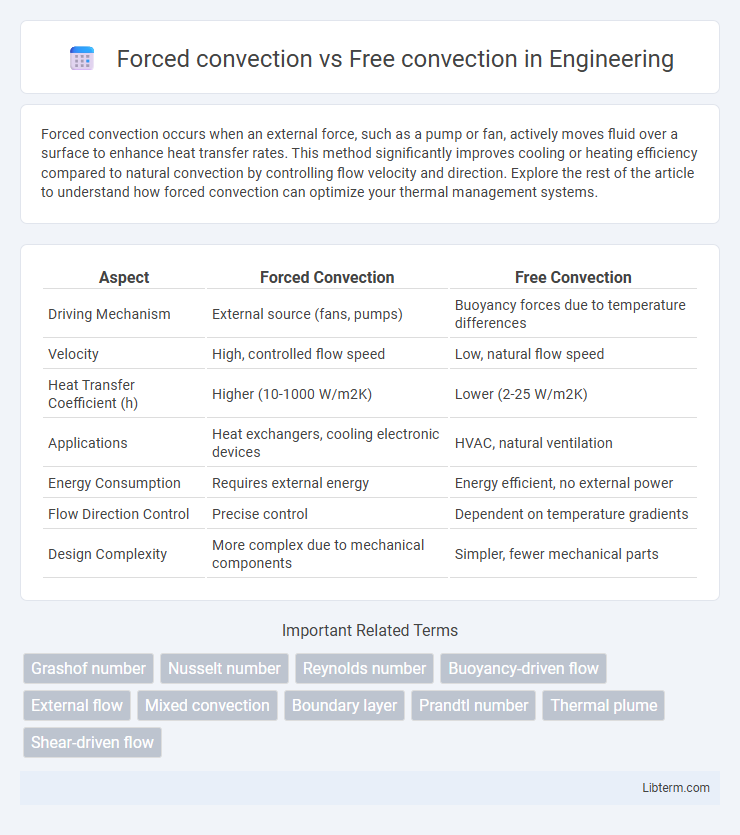Forced convection occurs when an external force, such as a pump or fan, actively moves fluid over a surface to enhance heat transfer rates. This method significantly improves cooling or heating efficiency compared to natural convection by controlling flow velocity and direction. Explore the rest of the article to understand how forced convection can optimize your thermal management systems.
Table of Comparison
| Aspect | Forced Convection | Free Convection |
|---|---|---|
| Driving Mechanism | External source (fans, pumps) | Buoyancy forces due to temperature differences |
| Velocity | High, controlled flow speed | Low, natural flow speed |
| Heat Transfer Coefficient (h) | Higher (10-1000 W/m2K) | Lower (2-25 W/m2K) |
| Applications | Heat exchangers, cooling electronic devices | HVAC, natural ventilation |
| Energy Consumption | Requires external energy | Energy efficient, no external power |
| Flow Direction Control | Precise control | Dependent on temperature gradients |
| Design Complexity | More complex due to mechanical components | Simpler, fewer mechanical parts |
Introduction to Convection: Fundamental Concepts
Convection involves heat transfer through fluid motion, categorized into forced and free convection based on flow causation mechanisms. Forced convection depends on external forces like fans or pumps to move the fluid, enhancing heat transfer rates significantly. Free convection relies on natural buoyancy effects from density variations due to temperature differences, which induce fluid motion without external input.
What is Forced Convection?
Forced convection is a heat transfer process where an external source, such as a fan or pump, causes fluid movement over a surface to enhance heat exchange. This method significantly increases the heat transfer rate compared to natural convection by controlling fluid velocity and direction. Industries like HVAC, automotive cooling, and electronics rely on forced convection to efficiently regulate temperature and improve system performance.
What is Free Convection?
Free convection is the heat transfer process that occurs naturally due to buoyancy forces induced by density differences in a fluid caused by temperature gradients. This phenomenon happens without external mechanical assistance, such as fans or pumps, relying solely on the fluid's natural movement as warmer, less dense fluid rises and cooler, denser fluid sinks. Free convection plays a critical role in numerous applications, including atmospheric circulation, ocean currents, and cooling of electronic devices.
Key Differences Between Forced and Free Convection
Forced convection involves fluid motion generated by external sources such as fans or pumps, resulting in higher heat transfer coefficients and controlled flow rates. Free convection relies on buoyancy forces caused by temperature-induced density differences in the fluid, leading to natural, slower fluid movement and typically lower heat transfer rates. The main distinctions lie in the driving mechanism, flow control, and efficiency of heat transfer between the two convection types.
Mechanisms Driving Forced and Free Convection
Forced convection relies on external sources such as fans, pumps, or blowers to induce fluid motion, enhancing heat transfer by increasing fluid velocity and turbulence. Free convection occurs due to buoyancy forces generated by density variations in the fluid caused by temperature gradients, resulting in natural fluid movement without external assistance. The driving mechanism in forced convection is mechanical energy input, while in free convection, it is thermal energy inducing buoyant flow.
Applications of Forced Convection in Industry
Forced convection is extensively utilized in industries requiring efficient heat transfer, such as in HVAC systems, electronic cooling, and chemical reactors, where controlled fluid movement enhances thermal regulation. Applications include cooling of electrical components in power plants, forced-air furnaces in manufacturing, and heat exchangers in petrochemical processing. This method provides precise temperature control and faster heat dissipation compared to free convection, making it essential in large-scale industrial operations.
Real-World Examples of Free Convection
Free convection occurs naturally when fluid motion is driven by buoyancy forces due to temperature differences, such as warm air rising from a heater or hot water circulating in a pot without stirring. Real-world examples include the natural airflow in a room caused by sunlight warming the floor or the ocean currents driven by surface water temperature variations. These processes highlight the significance of free convection in climate control, environmental systems, and heat transfer in everyday settings.
Factors Influencing Convection Efficiency
Forced convection efficiency depends on factors such as fluid velocity, surface roughness, and heat exchanger design, which enhance heat transfer by increasing the fluid motion over the surface. Free convection efficiency is influenced by temperature difference, fluid properties like viscosity and thermal conductivity, and the geometry of the heated surface, which drive natural buoyancy forces and fluid circulation. Both modes are affected by the surrounding environmental conditions and the physical characteristics of the fluid flow.
Advantages and Limitations of Each Method
Forced convection offers enhanced heat transfer rates by using external devices like fans or pumps to increase fluid motion, which improves cooling or heating efficiency in systems such as HVAC or electronic cooling. However, it requires additional energy input and maintenance for mechanical components, increasing operational costs and complexity. Free convection relies on natural buoyancy-driven fluid motion, making it energy-efficient and low-maintenance, but it provides slower heat transfer rates compared to forced convection and is less effective for high heat flux applications.
Conclusion: Choosing the Right Convection Approach
Forced convection dominates in applications requiring rapid and controlled heat transfer, utilizing external sources like fans or pumps to enhance fluid movement. Free convection relies on natural buoyancy-driven flow, suitable for low-intensity cooling or heating scenarios where simplicity and energy efficiency are prioritized. Selecting the appropriate convection method hinges on the desired heat transfer rate, system complexity, and operational costs.
Forced convection Infographic

 libterm.com
libterm.com